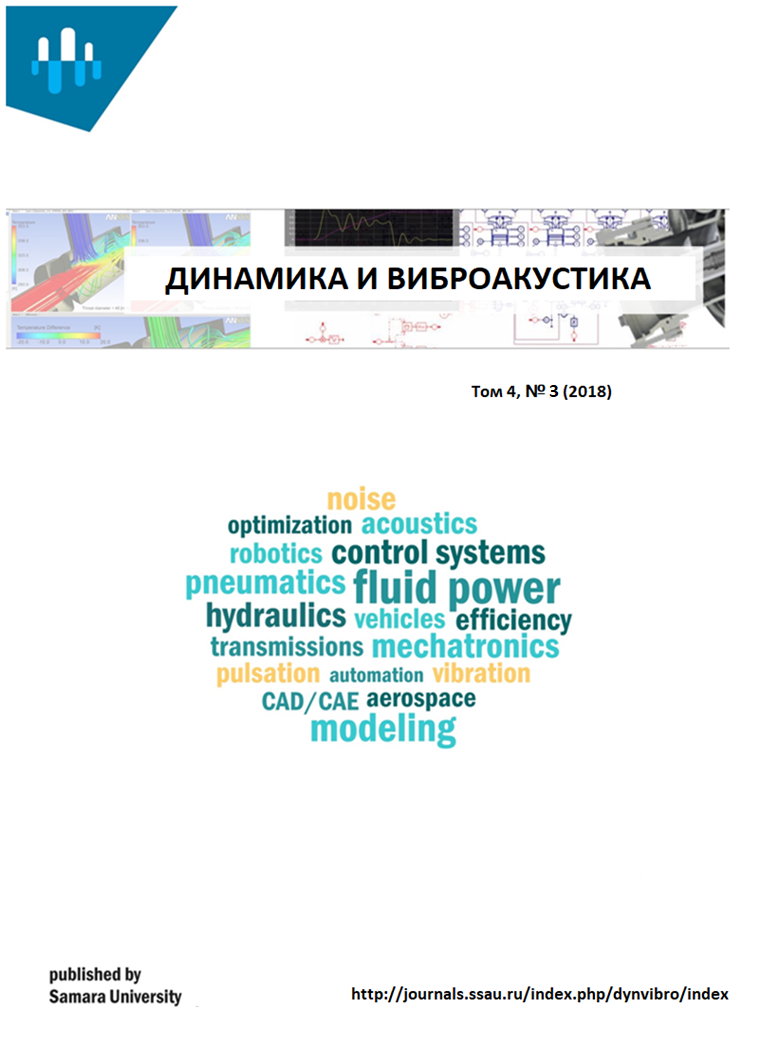Том 4, № 3 (2018): 16.09.2018
- Год: 2018
- Дата публикации: 16.09.2018
- Статей: 5
- URL: https://dynvibro.ru/dynvibro/issue/view/313
-
Описание:
опубликован 16.09.2018 г.
Весь выпуск
Статьи
Влияние различных конструктивных факторов на виброакустические характеристики электрогидравлических приборов
Аннотация
Одной из актуальных тем в области создания гидравлических систем
энергетических установок является снижение уровней гидродинамического шума и вибраций. При этом современные решения должны отвечать требованиям компактности, а наличие элементов в схемах регулирования должно сводиться к минимуму. Шумы дозвуковых турбулентных струй, образующихся в дросселирующих элементах, являются широкополосными источниками акустического шума электрогидравлических приборов. В силу этого большое и разностороннее внимание исследователей обращено как к методам
прогнозирования шума струи, так и к методам и средствам его снижения.
Авторами рассматривается снижение шума механизмов и устройств, поставляемых на корабли и суда, что также является исключительно актуальной задачей, стоящей перед разработчиками, так как требования к этим системам постоянно растут.
В статье описаны регулирующие органы управляющих электрогидравлических приборов систем подачи питательной воды энергетических установок. Проведен обзор использования сетчатых экранов в проточных частях приборов, отвечающих современным и перспективным требованиям. Представлены механизмы, за счет которых выполняется снижения шума и их реализация. Сделано заключение о применении методов по снижению уровня ГДШ данными конструкциями и даны рекомендации по дальнейшему
совершенствованию проточных частей для соответствия уровню современных и перспективных требований по шуму и вибрации.
 6-15
6-15


Неустойчивость и автоколебания в гидравлических следящих приводах
Аннотация
Существенным недостатком замкнутых систем является их склонность к неустойчивости. В реальных системах имеются потери, изменение величины передаваемой энергии и прочность элементов конструкции системы всегда ограничены, поэтому в таких системах чаще всего реализуются автоколебания. Автоколебательной системой принято называть устройства, способные создавать незатухающие колебания и характеризующиеся наличием источника энергии, клапана, регулирующего поступление энергии в колебательную систему, и обратной связи от колебательной системы на клапан. Для существования устойчивых автоколебаний необходим баланс получаемой и теряемой колебательной энергий, который возможен только в нелинейной системе. В работе поставлена задача численного и экспериментального исследования следящего электрогидравлического привода (ЭГСП) и установления на их основе основных механизмов неустойчивости и автоколебаний в приводе. Численные результаты можно существенно усилить, если от первоначальных перейти к обобщённым переменным. Безразмерная модель характеризуется тремя критериями гомохронности, коэффициентом затухания по вязкому трению и несколькими параметрическими критериями, среди которых наиболее значимым для следящих систем является безразмерный коэффициент обратной связи. По результатам численных исследований устойчивость привода и амплитуда автоколебаний зависят от комплекса, включающего в себя механическую и гидравлическую постоянную времени и безразмерный коэффициент обратной связи: чем больше гидравлическая постоянная по отношению к механической (следовательно сдвиг по фазе большой, а модуль мал) тем слабее усиление колебаний поршня за счет притока жидкости. Рассмотренная модель неустойчивости и автоколебаний является весьма грубой и приближенной: фактически отсутствует электрогидроусилитель, допущение об идеальной сжимаемости и неразрывности жидкости, утечки и перетечки в зазорах и уплотнениях, амплитуда колебаний скорости жидкости в трубопроводах будет больше, чем в цилиндре, в усилительно-преобразующих устройствах привода имеется насыщение расходной характеристики и другие нелинейные элементы, и др., но это возможные темы следующих исследований.
 16-25
16-25


Голографическая интерферометрия и ротор статорное взаимодействие при анализе колебаний рабочих колёс турбомашин
Аннотация
В статье рассмотрены два примера применения метода голографической интерферометрии для определения диаметральных форм колебаний вращающихся рабочих колёс турбомашин с учётом ротор статорного взаимодействия.
В первом примере на работающем компрессоре были проведены измерения напряжений в лопатках центробежного колеса. При использовании диффузора необычные колебания с большими амплитудами наблюдались на частоте вращения вблизи 18000 об/мин. Большие напряжения были обусловлены возбуждениями лопаток на относительно высоких частотах. В диапазоне этих частот было проведено исследование колебаний колеса на голографической установке при отсутствии вращения.
В статье для первого примера было показано, что значительные колебания лопаток колеса обусловлены ротор статорным взаимодействием и колебания вращающегося колеса центробежного компрессора совершаются по одному диаметру с окружностью.
Во втором примере изучались колебания колеса турбины на голографической установке и во время стендовых испытаний. При работе колеса турбины в составе ступени было найдено, что опасные напряжения возникают на частоте около 8000 Гц от действия 28‑й гармоники. При исследовании этого колеса на голографической установке была обнаружена форма колебаний с семью диаметрами на частоте 7893 Гц. Исходя из этого был сделан вывод, что опасные колебания по форме с семью диаметрами во вращающемся колесе возбуждались в результате ротор статорного взаимодействия.
 26-30
26-30


Виброустойчивость автомата осевой разгрузки тна
Аннотация
Изложены результаты исследования виброустойчивости автомата осевой разгрузки турбонасосного агрегата (ТНА). Разработана математическая модель устройства такого типа. Она позволяет на этапе проектирования определить влияние на виброустойчивость основных параметров системы осевой разгрузки – диапазона регулирования осевой силы, объёма разгрузочной камеры и сжимаемости рабочей жидкости. Приведены частотные характеристики виброактивности и переходные процессы по осевым перемещениям ротора при скачкообразном и ударном воздействиях.
 31-41
31-41


Управление процессом колебаний виброзащитных систем с динамическим гасителем
Аннотация
В статье рассматриваются теоретические аспекты управления процессом колебаний в системах виброзащиты с динамическим гасителем на основе использования современных информационных технологий. Дано обоснование принципа минимума и минимаксной процедуры формирования оптимального управления процессами колебаний. Показано, что прямой метод интегрирования уравнений состояния, при соблюдении минимаксной процедуры, позволяет непосредственно на каждом шаге интегрирования, находить значения компонент вектора оптимального управления. Алгоритм минимаксной процедуры принципа минимума использован для решения оптимизационной задачи динамического гашения колебаний, – найдена синтезирующая функция управления, которая позволяет устранить резонансные явления и обеспечить затухание переходных процессов в пределах одного периода кинематического воздействия.
 42-49
42-49











